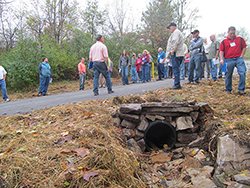Treated like dirt
Pennsylvania roads program draws national attention
04/02/2015
By Mike Casper
UNIVERSITY PARK, Pa. – A program for maintaining and improving Pennsylvania’s huge network of unpaved and rural roads is drawing nationwide attention as a model for how it’s done.
“There’s no other program this size that focuses on the environmental impact of rural roads,” says Steve Bloser, standing at the computer in his office at the Center for Dirt and Gravel Road Studies at Penn State’s Thomas D. Larson Pennsylvania Transportation Institute.
Bloser, the center’s director, is referring to Pennsylvania’s Dirt and Gravel Road Maintenance Program.
Roadways and water can be a costly and environmentally hazardous mix. Bloser credits Pennsylvania leaders for recognizing that as a major issue with lasting local, statewide and regional impacts.
Because the program is under the direction of the State Conservation Commission, said Bloser, “it is conservation and environment oriented.”
Pennsylvania is a natural for such a program, with more than 20,000 miles of unpaved roads, about 17,500 of which are owned by local municipalities and provide access for the state's agriculture, mining, forestry, and tourism industries as well as more than 3.6 million residents.
The Pennsylvania program, which began in 1998, has shown that designing and maintaining unpaved and low-volume roads to minimize environmental impacts and reduce the need for roadway maintenance saves tax dollars and helps preserve Pennsylvania’s environment.
The program’s success is now attracting the attention of transportation professionals across the nation, seeking to understand and emulate its proven approach.
Visitors from Arkansas attended the Fall 2014 program with the eventual intent to establish a similar program in their home state. Recent programs have also been attended by representatives from New York, New Jersey, California, Maryland, Maine, West Virginia, Michigan, and Arizona.
The program was amply showcased at the 2014 Dirt and Gravel Road Maintenance Workshop, in State College, Pa.
Hosted by the Center for Dirt and Gravel Road Studies at the Larson Institute, the event covered myriad technical subjects and included field visits to 12 project sites in Centre and Huntingdon counties.
As if charting maintenance for 20,000 road miles were not a daunting enough charge, Pennsylvania expanded the scope of its program last year. Section 9106 of the Pennsylvania Motor Vehicle Code provides funding for maintaining the dirt and gravel roads through Pennsylvania’s Dirt and Gravel Road Maintenance Program. In November 2013, funding was extended to include low-volume roads. Traffic counts are used to determine a roadway’s eligibility for maintenance funding as a low-volume road. Roads carrying less than 500 vehicles per day are considered low-volume roads.
Topics presented at the workshop included project bidding, traffic counts, stream crossing replacements policy, road reclamation, advanced technologies, and specialized equipment. The stream crossing replacements policy applies to dirt and gravel or low-volume crossings involving environmental impacts.
The field visits gave participants many learning opportunities, including a chance to diagnose needs and develop plans for an untreated roadway, view and gain background knowledge of recently completed drainage improvements, see a demonstration of advanced drainage technologies, and visit older sites to examine their maintenance longevity.
“Being able to see firsthand the broad range of situations represented through site visits is invaluable for working professionals,” noted Bloser.
“The workshop topics were very timely,” said Roy Richardson, coordinator of the Dirt and Gravel Road Program at the Pennsylvania State Conservation Commission. Richardson said that the agenda was comprehensive, yet the schedule included valuable opportunities to interact and meet participants.
Workshop participants also had the opportunity to renew their certification in the center’s comprehensive 2-Day Environmentally Sensitive Maintenance training, which is a requirement for grant funding.
More than 240 participants, representing county conservation districts, townships, boroughs, state parks, Pennsylvania Bureau of Forestry, Department of Environmental Protection, PennDOT, Pennsylvania Game Commission, and private-sector oil and gas companies attended the two-day event.
The event also featured 18 product vendors, including manufacturers of specialized pipe and geosynthetic fabric and road reclamation equipment.
For more information, visit http://www.dirtandgravel.psu.edu.



